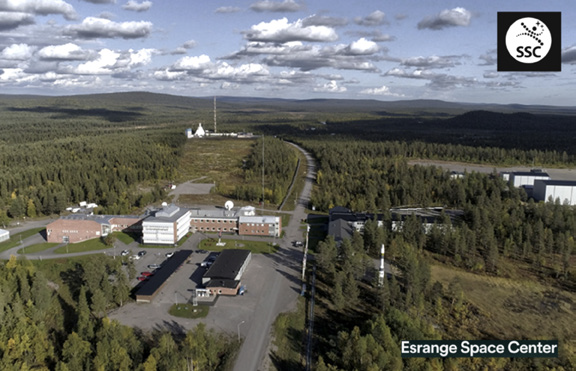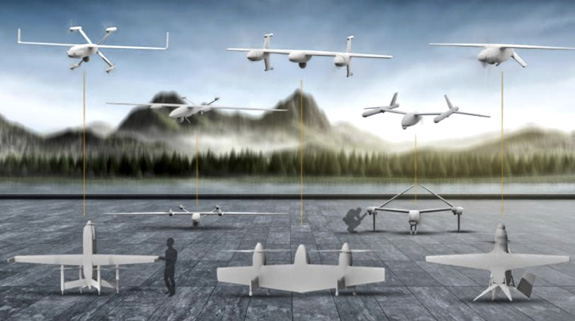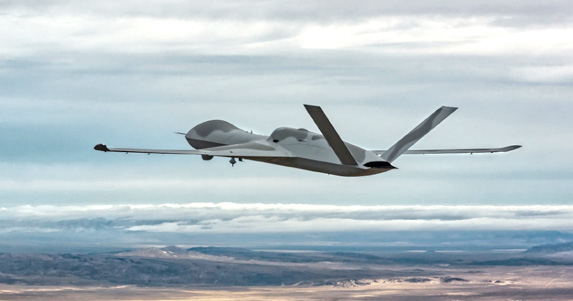Spacecom leader outlines vision for space Security
As Russian forces attacked Ukraine’s communication infrastructure in 2022, the Ukrainian military turned to a commercial satellite system to maintain operations. With over 7,000 satellites in orbit, that system provided internet access, which enabled battlefield communications, drone coordination and real-time intelligence imagery that revealed Russian troop movements.

The use of commercial space technology in conflict marked a turning point, demonstrating that even countries with limited space infrastructure can leverage space-based capabilities during war. That shift was the focus of an event hosted last month by the Chicago Council on Global Affairs, titled “Securing the Final Frontier with Gen. Stephen Whiting of U.S. Space Command.”
Whiting, commander of Spacecom and a Space Force officer with a background in satellite operations, launch systems and policy, highlighted General Whiting the growing commercialization of space and the emerging threats from adversaries like China and Russia.
While these advancements support global services and military operations, they also create new vulnerabilities. Whiting warned that rivals possess cybertools, jammers, lasers, direct ascent antisatellite weapons and co-orbital systems to disrupt U.S. space capabilities. He called recent reports that Russia may be exploring a nuclear weapon for space “incredibly irresponsible,” citing the potential to disrupt satellite networks critical to both civilian life and military readiness.
“Over the last 10 to 15 years, [the] U.S. commercial space industry has become the driving force of innovation,” he said, pointing to commercial reusable rockets and large satellite constellations. We can’t defend our country without space capabilities,” Whiting said, noting that adversaries have studied U.S. reliance on space since the 1991 Gulf War. “We don’t want a war in space,” Whiting said, “but we must be prepared to win if it comes.”
He pointed to a 2021 Russian antisatellite test that created 1,500 pieces of debris and China’s testing of fractional orbital bombardment systems as signs of the evolving threat landscape. Even everyday functions—financial transactions, emergency services and navigation apps—depend on GPS, which could be disrupted in a space conflict.
To that end, Spacecom works closely with allies such as Canada, the United Kingdom and Australia to project strength. A recent executive order launching the Golden Dome missile defense initiative further highlights space’s central role in national security. Whiting said commercial innovation enables the development of space-based sensors and interceptors needed to track hypersonic and orbital threats.
Reflecting on Ukraine’s use of commercial space systems, Whiting identified three key lessons: smaller nations can now access advanced capabilities, cyberattacks on satellites are a major risk and space-based tools—such as GPS, communications and intelligence—are essential to battlefield success. These takeaways guide Spacecom’s current priorities, including strategies to counter China’s surveillance.
News report by Army Major Wes Shinego, DoD News
SSC + Firefly planning orbital launch from Esrange following TSA signing between Sweden + U.S.
Swedish Space Corporation (SSC) and Firefly Aerospace are moving closer to a historic first satellite launch from Esrange Space Center in Kiruna, Sweden, following a Technology Safeguards Agreement (TSA) that was signed between Sweden and the United States on June 20.

The bilateral agreement, signed at the Embassy of Sweden in Washington D.C., provides the legal and technical framework for U.S. commercial launches from Swedish spaceports while ensuring proper handling of sensitive technology.
This agreement—only the sixth TSA signed by the United States with another country—allows SSC and Firefly Aerospace to continue building a comprehensive satellite launch service at Esrange Space Center and meet the increasing demand for orbital launch capabilities from mainland Europe.
Infrastructure development at SSC’s Esrange Space Center is progressing for Launch Complex 3C where Firefly’s Alpha rocket will launch. The tracking and control systems, security and depot facilities, and the Launch Control Center have already been stood up.
“I could not be more excited that the U.S. and Sweden have now finalized the TSA,” said Ulrika Unell, President, Orbital Launch & Rocket Test division, at SSC. “This agreement enables us to move forward into the next important phase of the infrastructure establishment at the spaceport of our Esrange Space Center—allowing for this comprehensive launch service to soon enter the market.”
“Finalization of the TSA gets us one step closer to launching our Alpha rocket from Sweden and filling a void for the European satellite market,” said Adam Oakes, Vice President of Launch at Firefly Aerospace. “In collaboration with SSC, we’re building on the existing infrastructure at Esrange to move quickly and meet the responsive space needs of our NATO partners and commercial customers. This TSA agreement removes the regulatory barriers and provides customers with additional assurance that the U.S. and Sweden are committed to an orbital launch capability from Esrange.”
“Adding this capability in mainland Europe will strengthen Sweden’s and Europe’s capabilities and competitiveness in the space arena, as well as our relations with the U.S. and NATO,” said Charlotta Sund, CEO at SSC.
DARPA to demonstrate revolutionary drone capabilities for warfighters
Five cutting-edge unmanned aerial systems (UAS) are slated to begin flight testing later this month to highlight the versatility of vertical take-off and landing for UAS weighing less than 330 pounds.

The vertical take-off and landing (VTOL) aircraft for the demonstration, known as EVADE – Early VTOL Aircraft Demonstration – will boast significantly enhanced range, endurance and control compared to existing VTOL UAS of similar size. The primary objective for EVADE is to demonstrate rapid deployment of advanced UAS capabilities to the warfighter.
“With EVADE, our focus is on speed of development, not on first flight perfection,” said DARPA Program Manager, Phillip Smith, who is a Major in the U.S. Marine Corps Reserves and was previously deployed as an AV-8B Harrier pilot. “The faster we can get these demonstration aircraft airborne, the quicker we can identify and resolve any issues, and ultimately, deliver game- changing capabilities to our warfighters in the field.”
The EVADE initiative accelerates DARPA’s AdvaNced airCraft Infrastructure-Less Launch And RecoverY (ANCILLARY) program Phase 2 plan, which the agency initially projected to conduct flight testing in late 2026. By prioritizing the integration of autonomy and payloads, EVADE aims to rapidly demonstrate the critical value of this UAS size class.
Furthermore, by postponing specific requirements related to maximum physical dimensions and autonomous takeoff/landing in high sea states, the program has dramatically shortened the timeline to first flight.
To further accelerate production timelines and maximize resource efficiency, all EVADE platforms leverage the Sikorsky MATRIX flight autonomy algorithms developed in DARPA’s Aircrew Labor In-Cockpit Automation System (ALIAS) program. The autonomy software manages flight control and navigation needs for entire missions—from takeoff to landing—and will minimize the need for user interaction during long transit flights. Having standardized autonomy software across all five performers and designs also simplifies user engagement.
Complementing this, the Naval Surface Warfare Center Dahlgren Division’s payload management software Battle Management System (BMS) is used across all platforms, interfacing directly with the Tactical Assault Kit available to every warfighter.
The integrated suite of tools will allow ANCILLARY aircraft to immediately share relevant information to individual troops at the point of need. It also effectively eliminates the need for dedicated ground control stations, thereby reducing programmatic and operational costs.
Artististic rendition of five performer designs for the DARPA ANCILLARY program’s EVADE demonstration. Image shows vertical takeoff-and-landing position and forward flight orientation, to scale, for each aircraft.
“EVADE is designed to democratize air power across the military, empowering the smallest operational units to directly receive and control an air asset when needed,” Smith said. “We’re testing five potential mission sets and payloads to showcase the breadth of capabilities EVADE can provide: logistics, communications relay, weapons delivery, synthetic aperture radar, and ISR/ RSTA (intelligence, surveillance, reconnaissance, and target acquisition).”
The five ANCILLARY designs vary in their capabilities, but all have a minimum of 12 hours of endurance at 100 nautical miles with a 60-pound payload.
“I think of these aircraft as ‘flying trucks,’” Smith said. “They have a high load fraction for their size and VTOL configurations and can be readily adapted to support a wide range of missions by carrying the necessary payload.”
The five performers in EVADE—AeroVironment, Griffon Aerospace, Karem Aircraft, Method Aeronautics, and Sikorsky—show some of the ways these aircraft can be optimized for different strengths, including: VTOL control, airspeed, storage capacity, cruise altitude, time on station, powertrain configurations, and control methodologies.
“With ANCILLARY, we aim to cultivate a thriving supplier ecosystem for these drones, or similar-sized systems, that can fundamentally transform the capabilities and situational awareness available to every warfighter,” Smith said. “We’re invested in the success of each UAS we’re testing. The U.S. military requires a diverse portfolio of performers capable of maximizing design trade-offs to achieve success across an array of mission sets.”
To help accelerate transition to the field, the ANCILLARY team has worked the certification process concurrently with aircraft design and testing, while also ensuring the performers and their supply chains are ready for rapid, on- demand aircraft production.
“We’re taking a full 360 look at what it takes—considering performance, cost, usability, interoperability, certification, manufacturing, etc.to ensure we rapidly deliver a game changing capability,” Smith said. “We’ve got five outstanding American companies we expect to be ready to accept and deliver orders at scale within the upcoming budget year.”
The under-330-pound (150 kilograms) maximum gross takeoff weight threshold for ANCILLARY aircraft is a pivotal factor. To date, the Department of Defense has required any drone over 55 pounds (25 kilograms) be owned by an aviation unit and operated by a fully licensed pilot, creating significant barriers to widespread fielding.
On a case-by-case basis, aircraft up to 330 pounds are now permitted to be purchased and operated by a non-aviation unit. DoD policies around drones of this size are evolving and the department is considering a policy change to allow UAS operators to fly all drones of this size without requiring special permissions.
“ANCILLARY fills a critical gap, bringing operational capabilities comparable to much larger—Group 4 and 5—drones to smaller units, such as Army, Marine Corps, special operations units or a ship’s company,” Smith said. “These drones can be deployed without additional infrastructure or equipment, even in austere environments—offering a game-changing toolset for warfighters.”
The ANCILLARY program is structured to facilitate rapid spiral development – an iterative model that reduces risk throughout the design lifecycle of the demonstration aircraft—to improve existing features and add new capabilities. Examples include additional weather hardening, adding the autonomy algorithms and sensors necessary for takeoff and landing at sea during storms, and improving engine efficiency, among other enhancements. DARPA will
not necessarily carry out all the planned development spirals, but the path is in place. DARPA intends to transition the aircraft and capabilities developed under the ANCILLARY program to the U.S. military services by the end of the 2025 calendar year.
Newest groundbreaking GA -ASI autonomous jet Demo includes successful simulated shoot-down
General Atomics Aeronautical Systems, Inc. recently completed a first-of-its-kind test involving multiple aircraft and advanced software that included a successful simulated autonomous shoot-down.

A GA-ASI-owned MQ-20 Avenger® unmanned jet used the latest government reference autonomy software in an exercise involving multiple live and virtual aircraft—as well as software supplied by Shield AI. As software- defined mission capabilities are evolving so quickly, it’s critical that aircraft hardware be agnostic as to the origins of these upgrades.
GA-ASI’s flights have underscored how compliance with what are called “government reference architectures” enables essential interoperability for hardware and software.
In the latest exercise, the MQ-20 Autonomous Collaborative Aircraft demonstrated that it could marshal; do dynamic midair station-keeping with several real aircraft; patrol a simulated combat area; make decisions autonomously; team with human command-and-control; and intercept two live aircraft autonomously—resulting in a simulated successful missile shot against the live targets.
The “live-on-live” event using representative Group 5 unmanned aerial vehicles (UAVs) proved how mature autonomy is today for future platforms.
Another feature of the test was a mid-flight transition from the government- provided suite of software to Shield AI’s Hivemind autonomy software, which subsequently performed a similar mission profile. This rapid switch aboard the MQ-20 took place without affecting aircraft stability or mission continuity. This demonstrates how standardized reference architectures are streamlining hardware and software integration, even from different vendors.
The test offered meaningful implications for the future of autonomy development. By adhering to a shared reference architecture, this model supports a flexible autonomy “app store” concept. It allows the government to incorporate capabilities from a broad vendor ecosystem without being tied to any single supplier. It promotes modularity, supports ongoing innovation, and enables more rapid deployment of autonomy features that align with the speed and agility often seen in commercial software development.
Auria awarded USSF JAM prototype in support of U.S. + Allied Warfighters
Auria has received an $8.1 million award of the Joint Antenna Marketplace (JAM) prototype by U.S. Space Force (USSF) Space Systems Command (SSC).

Auria is one of two companies that will each develop and deploy a secure, cloud-based application to provide dynamic satellite operations, enabling faster, more adaptive, and mission-responsive satellite contact management in support of the USSF’s growing mission demand.
The JAM prototype was awarded through a Space Enterprise Consortium (SpEC) Other Transaction Authority (OTA) and seeks to establish a flexible global framework that integrates satellite ground entry points with cloud
data centers for real-time satellite command and control. At its core, Auria’s solution streamlines contact scheduling, significantly enhancing Space Control Network (SCN) capabilities to enable satellite contacts within seconds and dynamic replanning as mission priorities shift.
The prototype integrates mission-proven, commercial off-the-shelf (COTS) products deployed on a secure cloud infrastructure with enforced Zero Trust Architecture (ZTA) to optimize coordination between Satellite Operations Centers (SOCs) and Antenna Providers (APs). This approach enables adaptive resource allocation, simplified operational workflows, and scaling to meet future demands without the need for architectural rework.
This system will enhance the operational efficiency of U.S. and allied satellite operations by integrating both commercial and government satellites, offering secure, scalable solutions, and a secure boundary for operations while maintaining high flexibility in support of U.S. and allied lethal fighting forces.
Karina Arushanyan, Executive Vice President at Auria, said, “This award underscores our commitment to delivering innovative solutions that address the Space Force’s pressing challenges, including the need to enhance the capacity of satellite operations to support the growing number of missions. Our team is grateful to Space Systems Command for their trust, and we are excited to demonstrate how our adaptive scheduling and secure, scalable technologies can meet the evolving demands of satellite operations.”



